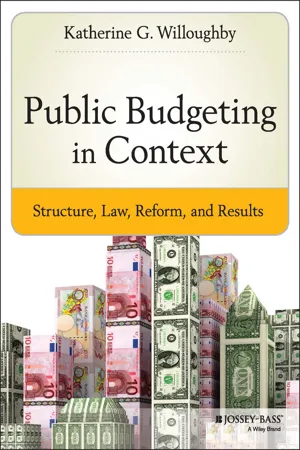
- English
- ePUB (mobile friendly)
- Available on iOS & Android
About this book
Public budgeting structure, process, legal framework and policy with examples from industrialized and developing countries
Public Budgeting in Context examines budgeting at all levels of U.S. government—federal, state, and local—and in a sample of governments around the world. The book assesses the context of public budgeting in these governments, especially the legal foundations for its practice and how the process and final budgets are impacted by governance structures, laws, various budget actors and different branches of government. The author presents focused attention on the influences on government budgets of the executive, legislative and judicial branches of government, the bureaucracy, the public and the media. In light of worldwide fiscal malaise, especially during and since the Great Recession, this book illustrates the heightened complexity of the budgeting environment that pervades all governments today—industrialized or developing, large or small.
For those who like to dive into the details, the book presents numerous examples of public budgeting as practiced and points to the wealth of data available for analyses of the budgetary context and process, budget shares and results regarding virtually any government of interest. Chapters cover the constitutional and statutory provisions for budgeting in selected governments. Budget and policy agenda setting and executive leadership, legislative budget powers and the influence of the judiciary on modern government budgets are exposed. Budget execution requirements of the bureaucracy, the input of customers, clients and citizens to government budgets, and media influences on public budgets and agencies are highlighted. Budget mechanics—budget types, formats, timelines and reforms—are introduced and compared. Taxes and intergovernmental revenues are considered, with predominant tax choices at every level of government in the United States and those in a select, developing country represented. The book introduces an emerging method for investigating the outcomes of government spending—human rights budget analysis—and includes as an example the assessment of budget reform and results of public health spending in one selected government.
Highlights of Public Budgeting in Context
- Offers a comprehensive text for understanding public budgeting in governments of a variety of contexts and capacities and across different levels
- Written by a noted expert in the field of public budgeting and financial management
- Contains illustrative examples from industrialized and developing countries
- Guides to innumerable datasets with information about governments and their budgets
- Includes a companion website filled with templates for budget and fiscal analysis
Unravel the complex issues of modern public budgeting using this unique presentation of its practice in a variety of governments in the U.S. and a select sample from around the world.
Frequently asked questions
- Essential is ideal for learners and professionals who enjoy exploring a wide range of subjects. Access the Essential Library with 800,000+ trusted titles and best-sellers across business, personal growth, and the humanities. Includes unlimited reading time and Standard Read Aloud voice.
- Complete: Perfect for advanced learners and researchers needing full, unrestricted access. Unlock 1.4M+ books across hundreds of subjects, including academic and specialized titles. The Complete Plan also includes advanced features like Premium Read Aloud and Research Assistant.
Please note we cannot support devices running on iOS 13 and Android 7 or earlier. Learn more about using the app.
Information
Chapter One
Overview of Modern Public Budgeting
Struggle and compromise are the very essence of the democratic process and are necessarily reflected in the budget.—Harold D. Smith, director of the US Bureau of the Budget, 1944
LEARNING OBJECTIVES
- Define public budgets in several ways
- Distinguish between different types of public budgeting decisions
- Distinguish between public and private budgets
- Understand different perspectives about the role, growth, and size of government
- Compare several theoretical frameworks about public budgeting
- Conduct your own investigation of government size
- Distinguish budget principles applicable to the legislative and executive branches of government
WHAT IS A BUDGET?
- Chiefly dialect: a usually leather pouch, wallet, or pack; also, its contents
- Stock, supply
- A quantity (as of energy or water) involved in, available for, or assignable to a particular situation; also, an account of gains and losses of such a quantity (the global carbon budget)
-
- A statement of the financial position of an administration for a definite period of time based on estimates of expenditures during the period and proposals for financing them
- A plan for the coordination of resources and expenditures
- The amount of money that is available for, required for, or assigned to a particular purpose
Table of contents
- Cover
- Contents
- Title
- Copyright
- Dedication
- Preface
- Acknowledgments
- About the Author
- Chapter One: Overview of Modern Public Budgeting
- Chapter Two: Budget Foundations in Selected Countries
- Chapter Three: Budget Law and History of the US Federal Government
- Chapter Four: Budget Foundations in US States
- Chapter Five: Budget Foundations in US Local Governments
- Chapter Six: Executive Leadership and the Budget Agenda
- Chapter Seven: Budget Powers of the Legislative Branch
- Chapter Eight: Public Budgeting and the Courts: Judicial Influence on Economies and Budgets
- Chapter Nine: The Bureaucracy, Citizens, the Media, and Public Budgets
- Chapter Ten: Budget Mechanics and Reforms
- Chapter Eleven: Funding with Taxes and Other Revenues
- Chapter Twelve: The Results of Government Spending
- List of Abbreviations and Acronyms
- More from Wiley
- Index
- End User License Agreement